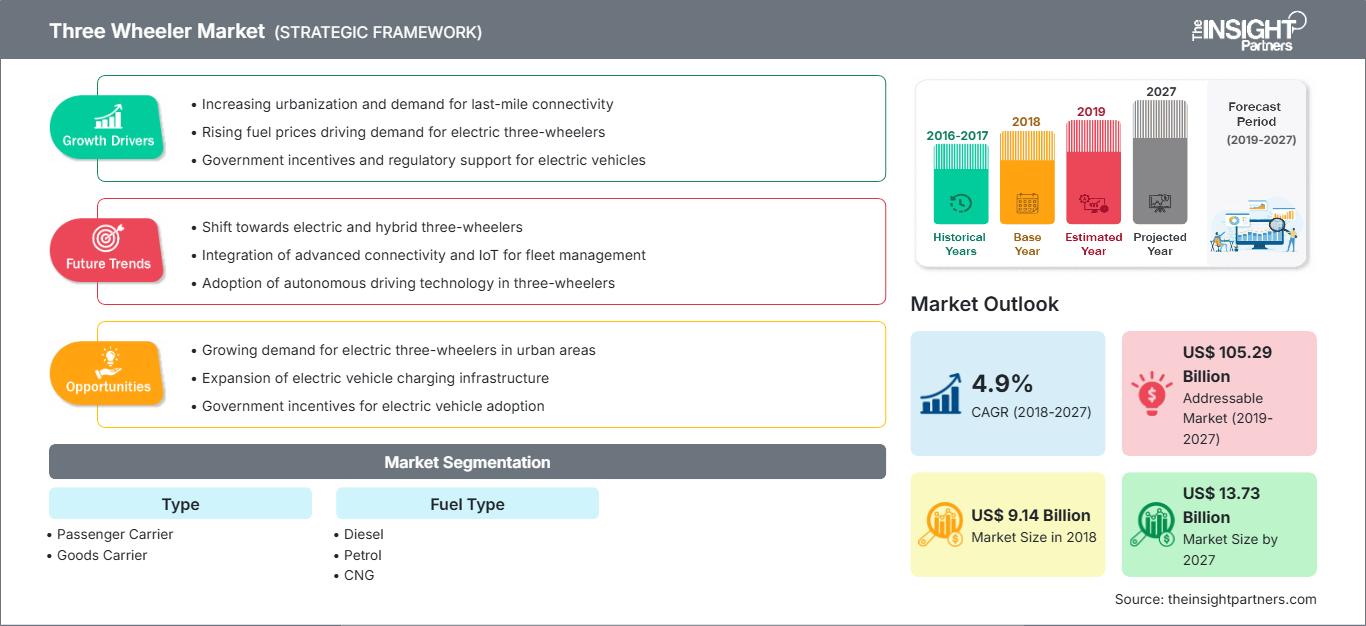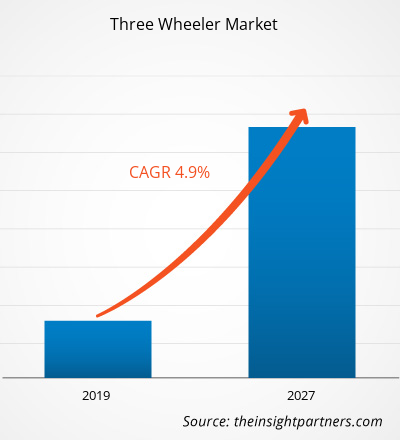Der Markt für Dreiräder wurde 2018 auf 9,14 Milliarden US-Dollar geschätzt und soll von 2019 bis 2027 mit einer durchschnittlichen jährlichen Wachstumsrate von 4,9 % wachsen und bis 2027 13,73 Milliarden US-Dollar erreichen.
Dreirädrige Personentransporter sind Dreiräder, die zum Transport von Passagieren verwendet werden. In dreirädrigen Personentransportern können mindestens drei und höchstens fünf bis sechs Passagiere reisen. In ländlichen Gebieten können je nach Bedarf mehr als sechs Passagiere in dreirädrigen Personentransportern reisen. E-Rikschas sind eine der Hauptarten von Dreirädern. E-Rikschas werden mit Batterien betrieben und sind umweltfreundliche Fahrzeuge. Im Vergleich zu herkömmlichen Dreirädern verursachen sie weniger Abgase und Lärm. E-Rikschas können fünf bis sechs Passagiere befördern. Die steigende Nachfrage nach elektrischen Dreirädern, das Bevölkerungswachstum und der steigende Bedarf an Fahrzeugen, die bei Verkehrsstaus in der Region helfen, haben das Wachstum des globalen Marktes für Dreiräder gefördert. Im Prognosezeitraum 2018 nimmt die Region APAC eine herausragende Stellung auf dem Dreiradmarkt ein. Länder wie Indien werden im Prognosezeitraum voraussichtlich das Inlands- und Exportgeschäftssegment dominieren. Darüber hinaus konzentrieren sich viele etablierte Unternehmen aus Indien auf die Herstellung von Dreirädern, die den BS-Normen (Bharat Stage) VI entsprechen, die bis 2020 umgesetzt werden, um die Emissionen von Feinstaub, Stickoxiden und Schwefel unter Kontrolle zu halten. Aufgrund des steigenden Bedarfs an Transportmitteln für ländliche und halbstädtische Gebiete des Landes und der wachsenden Bevölkerung ist in China ein signifikantes Wachstum zu beobachten, gefolgt von anderen asiatischen Ländern wie Thailand und Malaysia.
Passen Sie diesen Bericht Ihren Anforderungen an
Sie erhalten kostenlos Anpassungen an jedem Bericht, einschließlich Teilen dieses Berichts oder einer Analyse auf Länderebene, eines Excel-Datenpakets sowie tolle Angebote und Rabatte für Start-ups und Universitäten.
Dreiradmarkt: Strategische Einblicke

-
Holen Sie sich die wichtigsten Markttrends aus diesem Bericht.Dieses KOSTENLOSE Beispiel umfasst Datenanalysen, die von Markttrends bis hin zu Schätzungen und Prognosen reichen.
Die Automobilindustrie weltweit erlebt einen stetigen Anstieg der Anzahl mehrerer neuer Dreiradhersteller. Die Dreiradhersteller beobachten kontinuierlich die Entwicklung des Segments der elektrischen Dreiräder, da dieser Bereich das Interesse der Kunden weltweit weckt. Die globale Automobilindustrie erlebt einen deutlichen Wandel von herkömmlichen Dreirädern zu elektrischen Dreirädern.
Regierungen in verschiedenen Ländern ergreifen die Initiative zur Einführung von elektrischen Dreirädern. So startete das indische Ministerium für Schwerindustrie und öffentliche Unternehmen im März 2018 Phase II des FAME India Scheme, das am 1. April 2019 für die nächsten drei Jahre mit einer Gesamtbudgetunterstützung von 1,39 Milliarden US-Dollar gestartet wurde. Diese Phase soll hauptsächlich die Elektrifizierung des öffentlichen und Das FAME-Programm zielt darauf ab, 7.000 E-Busse, 500.000 E-Dreiräder, 55.000 E-Vierrad-Pkw und 100.000 E-Zweiräder durch Subventionen zu unterstützen. In dieser Phase des FAME-Programms soll eine angemessene öffentliche Ladeinfrastruktur aufgebaut werden, um das Vertrauen der Nutzer von Elektrofahrzeugen zu stärken. Das Ministerium für Schwerindustrie und öffentliche Unternehmen hofft dabei auf die Einbindung und aktive Teilnahme verschiedener Interessengruppen, darunter Industrieunternehmen, öffentliche Unternehmen und Regierungsbehörden. Die wichtigsten Akteure auf dem Markt streben die Entwicklung von Elektrofahrzeugen an. So hat beispielsweise der italienische Automobilhersteller Piaggio & C. SpA den Piaggio Ape E-City aus seiner Reihe der elektrischen Dreiräder Piaggio Ape Electrik auf den Markt gebracht. Das E-Auto ist mit einer austauschbaren Lithium-Ionen-Batterie ausgestattet und kann mit einer Ladung eine Reichweite von etwa 70–80 km zurücklegen. Darüber hinaus kündigte Euler Motors im August 2019 an, Anfang 2020 in Indien leichte elektrische Nutzfahrzeuge mit drei Rädern auf den Markt zu bringen.
In Indien und China gibt es zahlreiche Hersteller von Dreirädern und die Akzeptanz von Elektro-Dreirädern steigt von Jahr zu Jahr rasant an. Neben Indien und China verzeichnen auch Länder in Südamerika, wie Brasilien, Argentinien und im Nahen Osten und in Afrika wie Südafrika, Nigeria und Ägypten, eine rasante Verbreitung von Elektro-Dreirädern in der Automobilindustrie. Der asiatisch-pazifische Raum dominiert und erlebt dort ein enormes Wachstum in der Automobilindustrie. Dennoch benötigen die in der Region tätigen Automobilunternehmen mehr Partnerschaften mit Zulieferern, um die Verbreitung von Elektro-Dreirädern exponentiell zu steigern. Strategische Partnerschaften, Kooperationen, Verträge und Übernahmen mit anderen Marktteilnehmern sind für die Branchenakteure die wichtigsten Faktoren, um ihre Märkte voranzutreiben, was den Dreiradmarkt weltweit in den kommenden Jahren voraussichtlich ankurbeln wird.
Typ-Einblicke
Im Typ-Segment haben Personentransporter den größten Anteil am globalen Markt für Dreiräder. Personentransporter sind die günstigsten Transportmittel, die sich verschiedene private Transportunternehmen und Einzelpersonen leisten können, deren Einkommen aus Transportjobs stammt. Das Wachstum des Segments wird durch die steigende Nachfrage nach günstigen Personentransportern vorangetrieben, z. B. aufgrund des Mangels an geeigneten Straßen, Dreirädern, hauptsächlich aufgrund unzureichender Transportmöglichkeiten und städtischer Gebiete mit starken Verkehrsstaus.
Kraftstoff-Einblicke
Der Markt für Dreiräder ist nach Kraftstoffart in Diesel, Benzin, CNG, LPG und Elektro unterteilt. Das Benzinsegment hat den dominierenden Anteil am globalen Markt für Dreiräder.
initiative ist eine Strategie, die von Unternehmen verfolgt wird, um ihre Präsenz weltweit zu erweitern und die wachsende Kundennachfrage zu befriedigen. Die Marktteilnehmer auf dem Dreiradmarkt konzentrieren sich hauptsächlich auf Produkt- und Serviceverbesserungen durch die Integration fortschrittlicher Funktionen und Technologien. Durch den Abschluss von Partnerschaften, Verträgen, Joint Ventures und die Eröffnung neuer Niederlassungen auf der ganzen Welt versuchen Unternehmen, ihren Marktanteil und ihre Markenpräsenz zu erhöhen. Die meisten Marktinitiativen wurden im asiatisch-pazifischen Raum beobachtet, der ein hohes Potenzial für zukünftiges Marktwachstum aufweist. Einige davon sind unten aufgeführt:
2019: Im Dezember 2019 gab Greaves Cotton eine Partnerschaft mit der TVS Motor Company bekannt. Im Rahmen dieser Partnerschaft würde Greaves Cotton als autorisiertes Servicecenter für die Dreiräder von TVS Motor in Indien fungieren.2018: ATUL Auto Limited ging eine Partnerschaft mit JBM Industries ein, einem in Indien ansässigen Autoteilehersteller. Das Unternehmen hat sich zusammengeschlossen, um sein Geschäft mit dreirädrigen Elektroautos auszubauen.
Dreiradmarkt
Die Analysten von The Insight Partners haben die regionalen Trends und Faktoren, die den Markt für Dreiräder im Prognosezeitraum beeinflussen, ausführlich erläutert. In diesem Abschnitt werden auch die Marktsegmente und die geografische Lage in Nordamerika, Europa, dem asiatisch-pazifischen Raum, dem Nahen Osten und Afrika sowie Süd- und Mittelamerika erörtert.Umfang des Marktberichts für Dreiräder
| Berichtsattribut | Einzelheiten |
|---|---|
| Marktgröße in 2018 | US$ 9.14 Billion |
| Marktgröße nach 2027 | US$ 13.73 Billion |
| Globale CAGR (2018 - 2027) | 4.9% |
| Historische Daten | 2016-2017 |
| Prognosezeitraum | 2019-2027 |
| Abgedeckte Segmente |
By Typ
|
| Abgedeckte Regionen und Länder |
Nordamerika
|
| Marktführer und wichtige Unternehmensprofile |
|
Dichte der Marktteilnehmer auf dem Dreiradmarkt: Verständnis ihrer Auswirkungen auf die Geschäftsdynamik
Der Markt für Dreiräder wächst rasant, angetrieben von der steigenden Endverbrauchernachfrage aufgrund von Faktoren wie sich entwickelnden Verbraucherpräferenzen, technologischem Fortschritt und einem stärkeren Bewusstsein für die Produktvorteile. Mit steigender Nachfrage erweitern Unternehmen ihr Angebot, entwickeln Innovationen, um den Bedürfnissen der Verbraucher gerecht zu werden, und nutzen neue Trends, was das Marktwachstum weiter ankurbelt.

- Holen Sie sich die Dreiradmarkt Übersicht der wichtigsten Akteure
- Personentransporter
- Gütertransporter
Markt für Dreiräder – Nach Kraftstoffart
- Diesel
- Benzin
- CNG
- LPG
- Elektro
Globaler Markt für Dreiräder nach Regionen
-
Nordamerika
- USA
- Kanada
- Mexiko
-
Europa
- Frankreich
- Deutschland
- Italien
- Großbritannien
- Russland
- Übriges Europa
-
Asien-Pazifik
- China
- Indien
- Südkorea
- Japan
- Australien
- Übriger Asien-Pazifikraum
-
Übriger Welt
- Afrika
- Lateinamerika
Firmenprofile
- ATUL Auto Limited
- Bajaj Auto Ltd.
- JS AUTO (P) LTD.
- Mahindra & Mahindra Ltd.
- Piaggio & C. SpA
- Scooters India Limited
- Speego Vehicles Co Pvt Limited
- Terra Motors Corporation
- TVS Motor Company
- Xianghe Qiangsheng Electric Tricycle Factory
- Historische Analyse (2 Jahre), Basisjahr, Prognose (7 Jahre) mit CAGR
- PEST- und SWOT-Analyse
- Marktgröße Wert/Volumen – Global, Regional, Land
- Branchen- und Wettbewerbslandschaft
- Excel-Datensatz
Aktuelle Berichte
Verwandte Berichte
Erfahrungsberichte
Grund zum Kauf
- Fundierte Entscheidungsfindung
- Marktdynamik verstehen
- Wettbewerbsanalyse
- Kundeneinblicke
- Marktprognosen
- Risikominimierung
- Strategische Planung
- Investitionsbegründung
- Identifizierung neuer Märkte
- Verbesserung von Marketingstrategien
- Steigerung der Betriebseffizienz
- Anpassung an regulatorische Trends






















 Kostenlose Probe anfordern für - Dreiradmarkt
Kostenlose Probe anfordern für - Dreiradmarkt